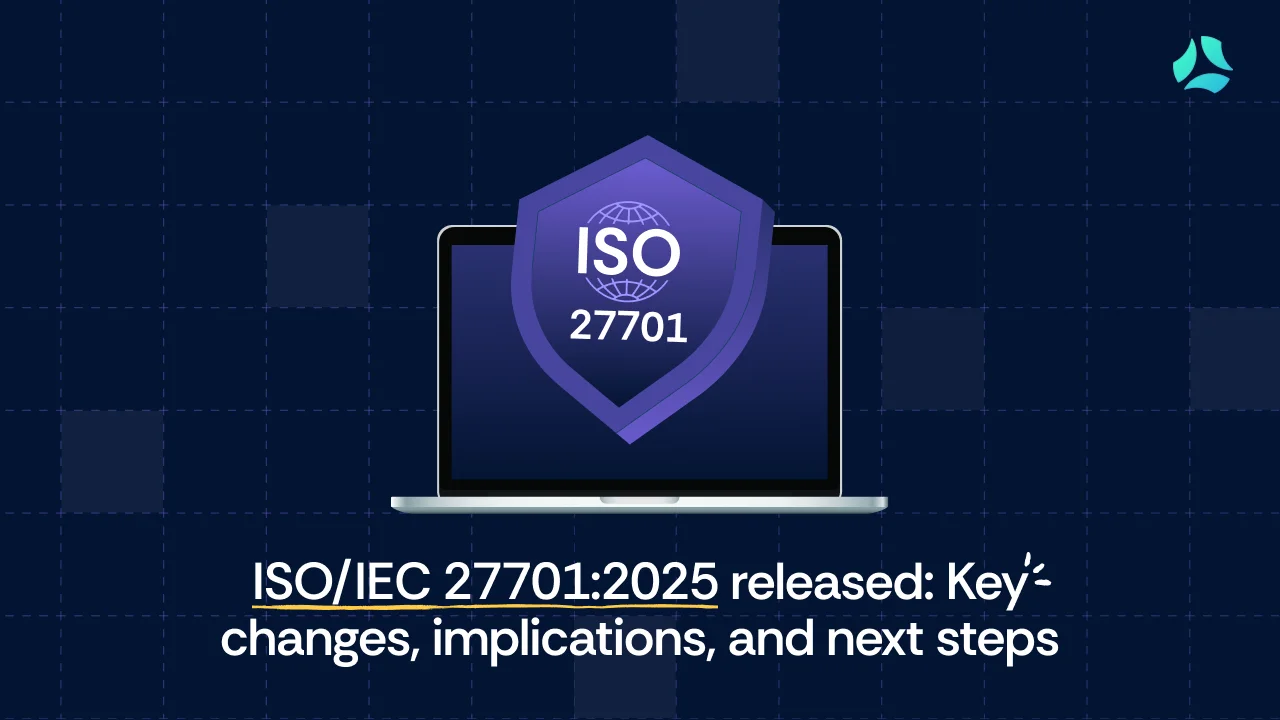Top 5 compliance standards shaping modern business

Businesses today face increasing pressure to meet regulatory requirements while safeguarding sensitive data. Without a structured approach, managing compliance and security risks can feel overwhelming.
This is where compliance standards come in—they provide clear, enforceable requirements for managing risks, maintaining regulatory compliance, and ensuring accountability to legal or industry mandates. But with so many standards out there, how do you choose the right one?
In this guide, we’ll break down five essential compliance standards, their benefits, and how automation can simplify compliance management for your business.
What are compliance standards?
Compliance frameworks provide structured guidelines and controls that help organizations meet industry regulations, protect sensitive data, and manage various risks, including cybersecurity, financial, and operational risks. These frameworks outline best practices for risk management, data security, and operational integrity, enabling businesses to comply with legal and regulatory requirements efficiently.
Why are compliance standards important?
Compliance frameworks help organizations mitigate security risks, avoid legal penalties, and build trust with customers and stakeholders. By implementing a structured compliance framework, businesses can:
- Strengthen security posture and reduce vulnerabilities
- Ensure adherence to industry regulations and legal requirements
- Avoid financial penalties and reputational damage
- Improve operational efficiency and risk management
How to choose the right compliance standard for your business
Different industries have unique regulatory requirements, making it essential to choose a compliance framework that aligns with sector-specific risks and obligations. For example, HIPAA applies to healthcare, while PCI DSS is relevant for businesses handling payment card data.
Additionally, compliance requirements vary by region. Organizations must consider regulations like GDPR in Europe or CCPA in California to meet jurisdictional standards.
Key features to look for when choosing a compliance standard
When selecting a compliance framework, consider the following factors:
- Scope and coverage: Ensure the framework aligns with your industry and regulatory requirements.
- Compliance process and renewal policies: Understand the steps involved in achieving compliance, documentation requirements, and ongoing renewal expectations.
- Integration with existing security programs: Choose a framework that fits seamlessly into your existing compliance infrastructure.

Five common compliance standards
Compliance frameworks help businesses maintain regulatory alignment, reduce security risks, and streamline governance. Below are five widely adopted compliance frameworks:
1. GDPR (General Data Protection Regulation)
The General Data Protection Regulation (GDPR) is an EU law governing how organizations collect, store, and process personal data. It mandates data protection measures, transparency in data handling, and a legal basis for processing—like consent or contractual necessity.
Key benefits:
- Strengthens consumer privacy rights
- Applies globally to businesses handling EU residents’ data
- Enforces strict penalties for non-compliance
2. HIPAA (Health Insurance Portability and Accountability Act)
HIPAA sets strict U.S. federal regulations for protecting the privacy and security of healthcare data. Covered entities and business associates must implement safeguards to secure electronic Protected Health Information (ePHI).
Key benefits:
- Ensures confidentiality and security of patient data
- Reduces risks of data breaches and legal liabilities
- Required for healthcare providers, insurers, and vendors handling health data
3. PCI DSS (Payment Card Industry Data Security Standard)
PCI DSS applies to entities handling cardholder data (merchants, processors, financial institutions) that process, store, or transmit credit card information. It mandates specific security controls to protect payment data and reduce breach risks.
Key benefits:
- Enhances payment security and fraud prevention
- Required for merchants and service providers handling card transactions
- Protects customer financial data from breaches
4. SOX (Sarbanes-Oxley Act)
SOX is a U.S. federal law requiring public companies to maintain accurate financial reporting and internal controls. It holds executives accountable for financial disclosures and mandates audit trails.
Key benefits:
- Prevents corporate fraud and protects investors
- Required for U.S. public companies
- Strengthens financial transparency and accountability
5. CCPA (California Consumer Privacy Act)
The CCPA is a California state law granting consumers rights over their personal data, requiring businesses to ensure transparency, opt-out options, and data deletion capabilities.
Key benefits:
- Enhances consumer privacy rights
- Applies to businesses meeting revenue or data-handling thresholds
- Sets a precedent for U.S. privacy regulations
How to automate compliance management for security frameworks
Managing compliance manually is time-consuming and prone to errors. Organizations must continuously track regulatory changes, conduct audits, and document security measures—tasks that require significant time and effort.
Benefits of automation
Automating compliance streamlines processes, reduces administrative burden, and improves accuracy. Key benefits include:
- Real-time monitoring: Continuous compliance tracking without manual effort.
- Reduced audit burden: Automated evidence collection and reporting make audits faster.
- Faster remediation: Identifies compliance gaps and recommends corrective actions.
- Increased accuracy: Eliminates human errors in compliance tracking.
- Scalability: Supports compliance management across multiple frameworks and jurisdictions.
How Scrut helps you achieve and maintain compliance
Scrut simplifies compliance management by automating evidence collection, tracking regulatory requirements, and ensuring audit readiness. Its pre-mapped controls across multiple frameworks ensure comprehensive coverage, while seamless reporting and auditor collaboration accelerate the compliance process.

FAQs
What are compliance standards?
Compliance frameworks provide structured guidelines and controls to help organizations meet regulatory requirements, protect data, and manage cybersecurity risks.
Why is compliance with security standards important?
Compliance ensures organizations adhere to industry regulations, protect sensitive information, and avoid legal penalties. It also builds customer trust and improves operational security.
How do I choose the right compliance standard for my business?
The choice depends on industry regulations, geographic location, and company needs. Businesses should evaluate the framework’s scope, certification process, and alignment with existing security programs.
Is ISO 27001 a compliance standard?
Yes, ISO 27001 is an internationally recognized compliance framework for managing information security risks through an Information Security Management System (ISMS).


















